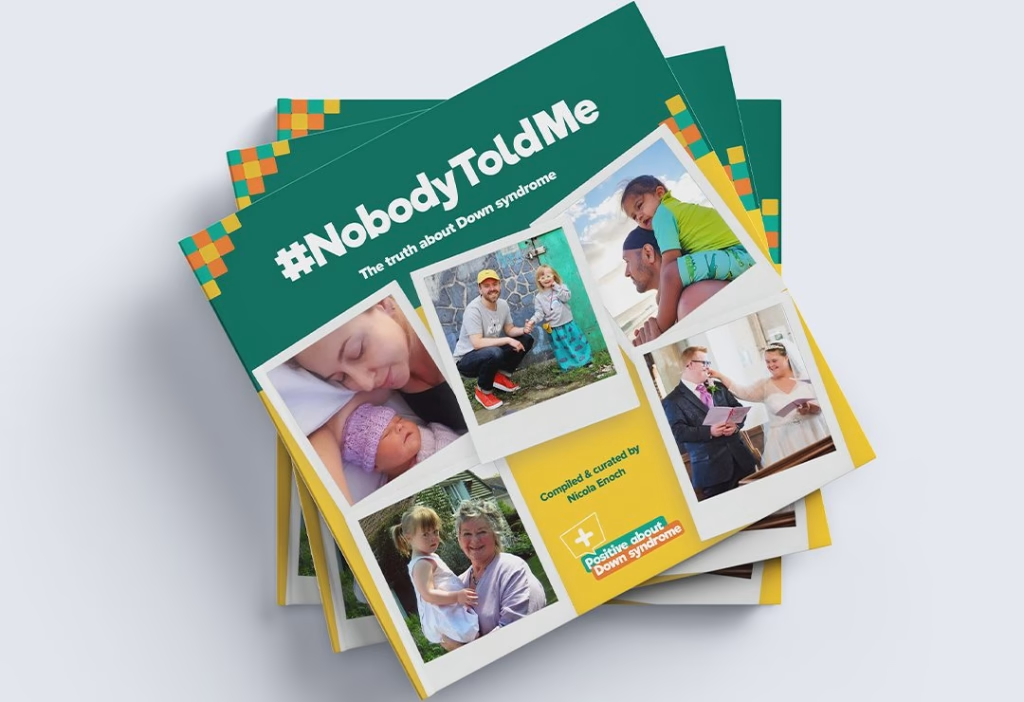What is Down syndrome?
Meet George Webster, actor, TV presenter and Mencap ambassador.
In this video George dispels five myths about Down syndrome.
Meet George Webster, actor, TV presenter and Mencap ambassador.
In this video George dispels five myths about Down syndrome.
If you’ve discovered that your baby (or a friend/family member’s baby) has or may have Down syndrome, you may be worried and afraid, unsure of what your future holds and what life will look like. At Down Syndrome UK we understand, and we are here for you; you are not alone.

Our #NobodyToldMe the truth about Down syndrome book is a collection of personal lived-experiences written by young people with Down syndrome, their friends and family. We post a copy with our congratulations and compliments to expectant and new parents when they connect via our closed Facebook groups.
Learning and development
Everyone with Down syndrome has a learning disability; with the right support, most will meet the usual childhood milestones and can make good progress at mainstream school. Having a learning disability does not mean a person can’t learn, it generally means it takes longer to master new skills. And as with the rest of the population, most children with Down syndrome become lifelong learners.
Physical characteristics
Historically people with Down syndrome have been represented by an outdated list of characteristics. At Down Syndrome UK, we see and value each person as a unique individual, with their own personality, strengths, and areas where they may need support to thrive.
Today’s reality for many people with Down syndrome is vastly different from past generations. There are higher expectations, more experience and greater opportunities for people with Down syndrome to be able to live their best lives.
Many people with Down syndrome are
Down syndrome is a naturally occurring genetic difference, usually involving an extra copy of chromosome 21 in every cell. This happens at the time of conception and is entirely random, there is no connection to anything parents do before or during pregnancy.
In around 99% of cases, having Down syndrome is not inherited and happens completely by chance.
While the likelihood of having a baby increases with parental age – especially after 35 – most babies with Down syndrome are born to younger women. The average age of a mother of a baby with Down syndrome is understood to be 29 years.
Babies with Down syndrome are born to families across the world, regardless of race, ethnicity, or background.
There are three types of Down syndrome
Every cell in the body has three copies of chromosome 21 instead of two. This is the most common form and occurs during cell division.
Part or all of an extra chromosome 21 attaches to another chromosome.
Only some cells have the extra chromosome 21, while others have the typical two copies.
The life expectancy for people with Down syndrome has dramatically improved over recent decades. In 1983, the average life expectancy was just 25 years. Today, it’s nearly 60 years and continuing to increase.
Why has life expectancy improved?
Some people with Down syndrome have additional health needs, but it’s important to note that not every person with Down syndrome will present with a health need. Additionally, none of the health needs that present in people with Down syndrome are unique only to them – all of them can be managed and treatments are well-documented.
Possible Conditions:
Early intervention and ongoing support can make a significant difference in outcomes for those with Down syndrome. Key areas of support include:
Reality: People with Down syndrome experience the full range of human emotions!
Reality: Many people with Down syndrome live semi-independently or independently
Reality: Many people with Down syndrome are employed and active community members
Reality: Each person is unique with individual personalities, interests, and abilities
The future continues to look brighter for people with Down syndrome. Advances in medical care, education, employment opportunities, and social inclusion mean that people with Down syndrome today can expect to live longer, healthier, and lead more independent lives than ever before.
At Down Syndrome UK, we’re committed to ensuring that every person with Down syndrome has the opportunity to live a fulfilling life and reach their full potential. We provide information, support, and advocacy to help make this vision a reality.
Key Takeaways:
It is vitally important that people have a contemporary understanding of what life is like having Down syndrome in modern Britain and that language used when speaking of people with Down syndrome is respectful and accurate. We have created some guidelines which we hope you will find helpful.
